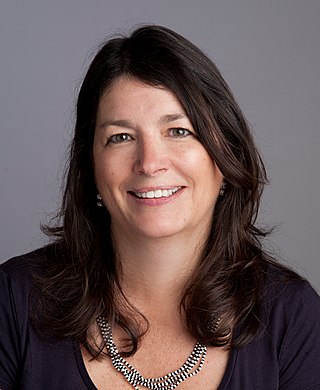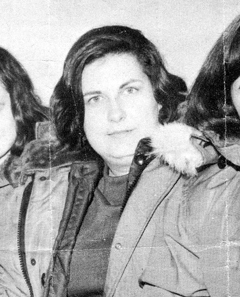Related Research Articles

The Byrd Polar and Climate Research Center (BPCRC) is a polar, alpine, and climate research center at Ohio State University founded in 1960.

The global temperature record shows the fluctuations of the temperature of the atmosphere and the oceans through various spans of time. There are numerous estimates of temperatures since the end of the Pleistocene glaciation, particularly during the current Holocene epoch. Some temperature information is available through geologic evidence, going back millions of years. More recently, information from ice cores covers the period from 800,000 years before the present time until now. A study of the paleoclimate covers the time period from 12,000 years ago to the present. Tree rings and measurements from ice cores can give evidence about the global temperature from 1,000-2,000 years before the present until now. The most detailed information exists since 1850, when methodical thermometer-based records began. Modifications on the Stevenson-type screen were made for uniform instrument measurements around 1880.

Lonnie Thompson, is an American paleoclimatologist and university professor in the School of Earth Sciences at Ohio State University. He has achieved global recognition for his drilling and analysis of ice cores from ice caps and mountain glaciers in the tropical and sub-tropical regions of the world. He and his wife, Ellen Mosley-Thompson, run the ice core paleoclimatology research group at the Byrd Polar Research Center.

Dome Fuji, also called Dome F or Valkyrie Dome, is an Antarctic base located in the eastern part of Queen Maud Land. With an altitude of 3,810 metres (12,500 ft) above sea level, it is the second-highest summit or ice dome of the East Antarctic Ice Sheet and represents an ice divide. Dome F is the site of Dome Fuji Station, a research station operated by Japan.

Maureen E. "Mo" Raymo is an American paleoclimatologist and marine geologist. She is the Co-Founding Dean of the Columbia Climate School, Director of the Lamont–Doherty Earth Observatory of Columbia University, the G. Unger Vetlesen Professor of Earth & Environmental Sciences, and Director of the Lamont–Doherty Core Repository at the Lamont–Doherty Earth Observatory of Columbia University. She is the first female climate scientist and first female scientist to head the institution.

The 1808 mystery eruption is one or potentially multiple unidentified volcanic eruptions that resulted in a significant rise in stratospheric sulfur aerosols, leading to a period of global cooling analogous to the Year Without a Summer in 1816.

Terry Jean Wilson is an international leader in the study of present-day tectonics in Antarctica. She has led large, international efforts, such as Polar Earth Observing Network (POLENET), to investigate the interactions between the Earth's crust and the cryosphere in Antarctica.

Amy Leventer is an American Antarctic researcher specialising in micropaleontology, with specific research interests in marine geology, marine biology, and climate change. Leventer has made over a dozen journeys to the Antarctic, which began at the age of 24 and led to the pursuit of her PhD.

Lois M. Jones was an American geochemist who led the first all-woman science team to Antarctica in 1969. They were also the first women to reach the South Pole. Jones was well regarded for her contribution to geological research in the McMurdo Dry Valleys, one of the few ice-free areas of Antarctica, and published many papers and abstracts.

Julie Michelle Palais is an American polar glaciologist who has made significant contributions to climate change research studying volcanic fallout in ice cores from both Greenland and Antarctica. For many years, starting in 1990, she played a pivotal role working at the National Science Foundation (NSF) as Program Director of the Antarctic Glaciology Program in the Division of Polar Programs, including many trips to both North and South Polar regions. Both the Palais Glacier and Palais Bluff in Antarctica were named in her honor and she has received many further recognitions for her distinguished career.

Christine Siddoway is an American Antarctic researcher, best known for her work on the geology and tectonics of the Ford Ranges in western Marie Byrd Land. Other discoveries relate to preserved records of continental-interior sedimentation during the Sturtian glaciation, Cryogenian Period, in Rodinia, and evidence of a reduced Pliocene extent of the West Antarctic ice sheet, based upon investigation of clasts transported to/deposited in deep water by Ice rafting in the Amundsen Sea.
Marilyn N. Raphael is a Trinidadian climatologist, best known for her work on climate change and variability in the high latitude southern hemisphere. She is a professor and former chair of the Department of Geography at UCLA, has authored an award-winning text, and sits in leadership positions on a number of international polar research initiatives.

Claire Lucille Parkinson is an American Earth scientist and climatologist at NASA's Goddard Space Flight Center.
Anne Grunow is a senior research scientist at Ohio State University in the Byrd Polar Research Center. She is also the current director of the Polar Rock Repository. Grunow is a geologist specializing in Antarctic tectonics, with her research using methods from geochronology and paleomagnetism.

The Quelccaya Ice Cap is the second largest glaciated area in the tropics, after Coropuna. Located in the Cordillera Oriental section of the Andes mountains in Peru, the cap covers an area of 42.8 square kilometres (16.5 sq mi) with ice up to 200 metres (660 ft) thick. It is surrounded by tall ice cliffs and a number of outlet glaciers, the largest of which is known as Qori Kalis Glacier; lakes, moraines, peat bogs and wetlands are also present. There is a rich flora and fauna, including birds that nest on the ice cap. Quelccaya is an important source of water, eventually melting and flowing into the Inambari and Vilcanota Rivers.
Eric Steig is a Canadian-American scientist specializing in polar climate, glaciology, isotope geochemistry, and ice core science.
Liz Thomas is a British climate scientist, specializing in paleoclimatology. Her research mainly focuses on historic climate variability in the Antarctic, and she oversees the British Antarctic Survey's work on collecting and studying ice cores.
Sarah Das is an American glaciologist and climate scientist. She works at the Woods Hole Oceanographic Institute in Woods Hole, Massachusetts.
References
- 1 2 3 4 "Ellen Mosley-Thompson | Council for the Advancement of Science Writing". casw.org. Archived from the original on 2018-07-04. Retrieved 2018-07-04.
- 1 2 3 4 "The Antarctic Sun: News about Antarctica - Ellen Mosley-Thompson (page 1)". antarcticsun.usap.gov. Retrieved 2018-07-04.
- 1 2 3 4 5 "Ellen Stone Mosley-Thompson". The Franklin Institute. 2014-09-08. Archived from the original on 2021-04-25. Retrieved 2018-07-04.
- 1 2 3 4 5 6 "Lonnie Thompson: Expert Q&A — NOVA | PBS". www.pbs.org. April 2009. Retrieved 2018-07-04.
- 1 2 "Climatologist Ellen Mosley-Thompson on warming in Antarctica". the Guardian. 2010-05-04. Retrieved 2018-07-04.
- 1 2 3 "Ellen Mosley-Thompson". Department of Geography. 2013-10-24. Retrieved 2020-03-13.
- 1 2 "Ellen Mosley-Thompson". ARCUS. Retrieved 2018-07-04.
- ↑ "Ellen Mosley-Thompson - Leadership". Leadership. Retrieved 2018-07-04.
- ↑ "2003 Annual Report" (PDF). AAAS. Retrieved Feb 22, 2020.
- ↑ "Ellen Mosley-Thompson". www.nasonline.org. Retrieved 2020-02-22.
- ↑ "Lonnie & Ellen Thompson – 2007 – Roy Chapman Andrews Society". roychapmanandrewssociety.org. Retrieved 2018-07-04.
- ↑ "Noted Geographer, Researcher Named To Ohio Women's Hall of Fame". Ohio State News. 2003-10-16. Archived from the original on 2018-07-04. Retrieved 2018-07-04.
- ↑ BBVA Foundation Frontiers of Knowledge Awards 2021